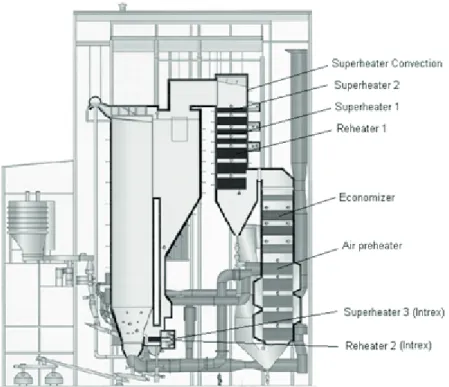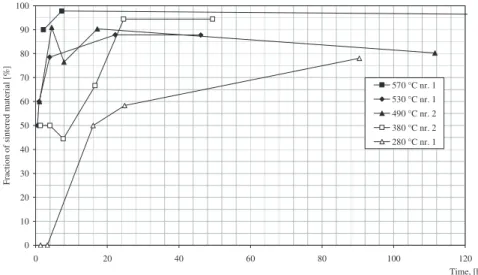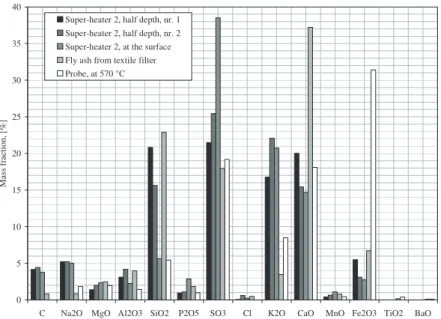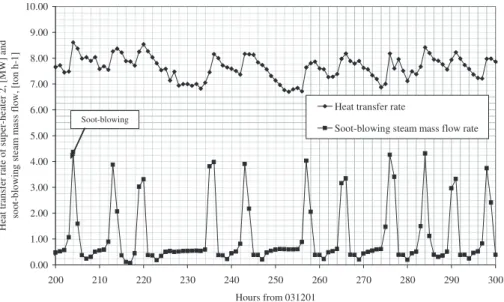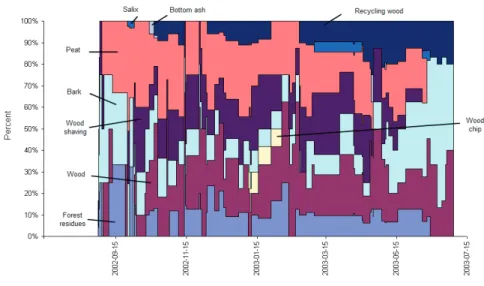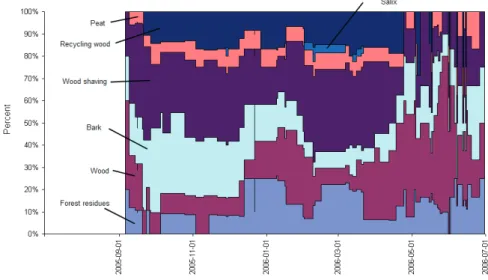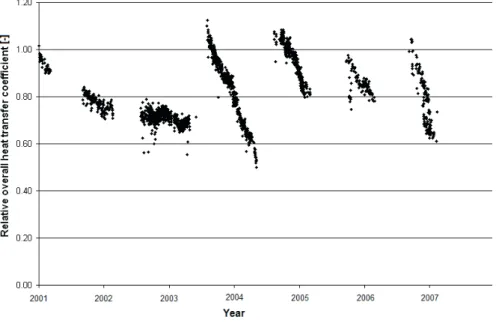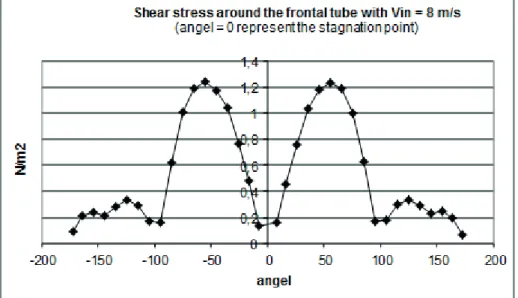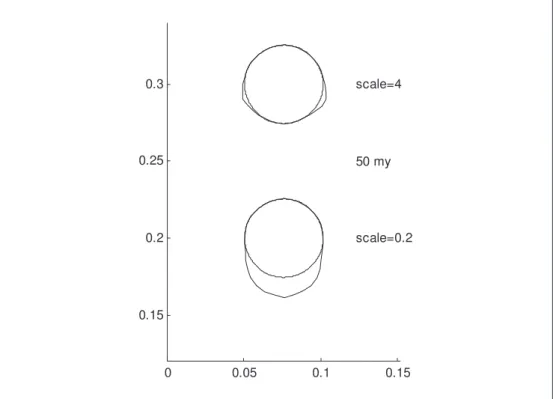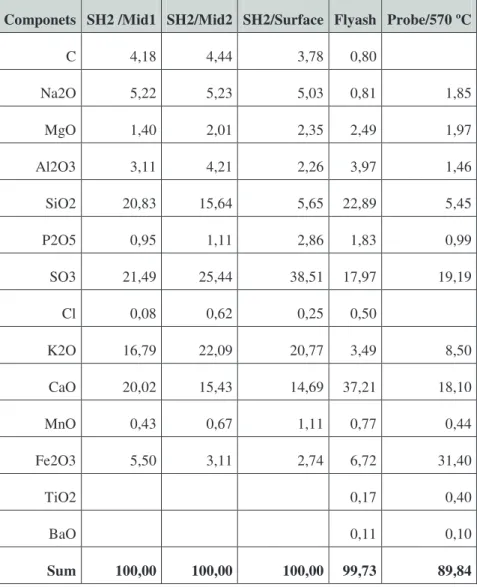Mälardalen University Press Dissertations No. 116
FOULING IN BIOMASS FIRED BOILERS
Jan Sandberg 2011
School of Sustainable Development of Society and Technology Mälardalen University Press Dissertations
No. 116
FOULING IN BIOMASS FIRED BOILERS
Jan Sandberg 2011
Mälardalen University Press Dissertations No. 116
FOULING IN BIOMASS FIRED BOILERS
Jan Sandberg
Akademisk avhandling
som för avläggande av teknologie doktorsexamen i energi- och miljöteknik vid Akademin för hållbar samhälls- och teknikutveckling kommer att offentligen försvaras
tisdagen den 20 december 2011, 13.30 i Delta, Mälardalens högskola, Västerås. Fakultetsopponent: Professor Alain Liné, LISBP-INSA de Toulouse
Akademin för hållbar samhälls- och teknikutveckling Copyright © Jan Sandberg, 2011
ISBN 978-91-7485-047-5 ISSN 1651-4238
Mälardalen University Press Dissertations No. 116
FOULING IN BIOMASS FIRED BOILERS
Jan Sandberg
Akademisk avhandling
som för avläggande av teknologie doktorsexamen i energi- och miljöteknik vid Akademin för hållbar samhälls- och teknikutveckling kommer att offentligen försvaras
tisdagen den 20 december 2011, 13.30 i Delta, Mälardalens högskola, Västerås. Fakultetsopponent: Professor Alain Liné, LISBP-INSA de Toulouse
Akademin för hållbar samhälls- och teknikutveckling Mälardalen University Press Dissertations
No. 116
FOULING IN BIOMASS FIRED BOILERS
Jan Sandberg
Akademisk avhandling
som för avläggande av teknologie doktorsexamen i energi- och miljöteknik vid Akademin för hållbar samhälls- och teknikutveckling kommer att offentligen försvaras
tisdagen den 20 december 2011, 13.30 i Delta, Mälardalens högskola, Västerås. Fakultetsopponent: Professor Alain Liné, LISBP-INSA de Toulouse
Abstract
This thesis describes a detailed investigation into fouling in biomass fired boilers according to fuel mixture, combustion conditions, transportation of particles by the flue gas and the probability of particles impinging and sticking onto heat transfer tubes. The effects of fouling on overall boiler performance and the efficacy of soot blowing are also investigated.
Both theoretical simulations and practical experiments on a 157 MW circulating fluidized bed boiler are presented.
The deposit thickness on and around a heat exchanger tube is shown to be mainly dependent on the ash particle size, as particles larger than 10 µm (Stokes number larger than 0.1) mainly impinge on the windward side of tubes. The study also shows that fuel containing small amounts of chlorine and zinc – common elements in recycled wood – may cause both higher deposit growth rates and rapid increases in corrosion rates. These elements (chlorine and zinc), together with alkali metals from the biomass have the potential to form sticky compounds that increase the deposit growth rate.
Reducing deposits by soot blowing is very effective at removing loose deposits but the hard sintered part of the deposits is almost unaffected. The use of recycled wood has a larger impact on the deposit growth rate than the soot blowing interval.
Numerical simulations show that deposits on the superheater tubes redistribute the heat transfer rate from the superheaters to reheater 1 and partially redistribute turbine power from the high pressure turbine to the intermediate pressure turbine
Summary
The use of biomass as fuel for boilers is promoted as a way of reducing the discharge of the greenhouse gas CO2. In comparison to boilers fired with
coal and oil, biomass-fired boilers are associated with increased complica-tions related to fouling and corrosion on the heat transfer surfaces. After combustion, unburnt inorganic matter in the vapour state, melts and solid particles are transported in the flue gas and can form deposits on heat trans-fer surfaces.
In order to understand the build up of deposits and how it affects boiler performance, the entire combustion and transport process has been ana-lysed. The analysis includes aspects such as boiler design, fuel properties, combustion conditions, particle transport phenomena and the probability of particles adhering to heat transfer tubes.
This thesis describes numerical simulation of particle trajectories, meas-urements of deposits using a specially designed deposit probe and a seven year investigation of on-site measurements of deposit depth and corrosion on the superheater tubes in a circulating fluidized bed (CFB) boiler in Väs-terås, Sweden. The deposit growth rate and the corrosion rate are correlated to the fuel used during the investigation period. These deposit measure-ments are also used as inputs to a dynamic model that simulates how deposits affect boiler performance.
Numerical simulations of particle trajectories in the vicinity of two su-perheater tubes were conducted in an Eulerian-Lagrangian mode that considered the flue gas and ash particle phase. Particle impingements on the tubes were investigated for different particle sizes. The results from the par-ticle trajectory simulations showed that parpar-ticles larger than 10 µm (Stokes number larger than 0.1) mainly impinge on the windward side of the first tube, but they also impinge on the sides of the second tube in the flue gas flow direction. In theory, two tubes can merge together due to this build up of deposits. This effect has been observed during boiler operations. Smaller particles are usually more dispersed due to turbulence and thermophorectic forces, resulting in a more even distribution on the surface of the tubes.
Probe measurements reveal that the deposit layer growth rate has a sig-nificant temperature and time dependence. After the initial deposit buildup a
Summary
The use of biomass as fuel for boilers is promoted as a way of reducing the discharge of the greenhouse gas CO2. In comparison to boilers fired with
coal and oil, biomass-fired boilers are associated with increased complica-tions related to fouling and corrosion on the heat transfer surfaces. After combustion, unburnt inorganic matter in the vapour state, melts and solid particles are transported in the flue gas and can form deposits on heat trans-fer surfaces.
In order to understand the build up of deposits and how it affects boiler performance, the entire combustion and transport process has been ana-lysed. The analysis includes aspects such as boiler design, fuel properties, combustion conditions, particle transport phenomena and the probability of particles adhering to heat transfer tubes.
This thesis describes numerical simulation of particle trajectories, meas-urements of deposits using a specially designed deposit probe and a seven year investigation of on-site measurements of deposit depth and corrosion on the superheater tubes in a circulating fluidized bed (CFB) boiler in Väs-terås, Sweden. The deposit growth rate and the corrosion rate are correlated to the fuel used during the investigation period. These deposit measure-ments are also used as inputs to a dynamic model that simulates how deposits affect boiler performance.
Numerical simulations of particle trajectories in the vicinity of two su-perheater tubes were conducted in an Eulerian-Lagrangian mode that considered the flue gas and ash particle phase. Particle impingements on the tubes were investigated for different particle sizes. The results from the par-ticle trajectory simulations showed that parpar-ticles larger than 10 µm (Stokes number larger than 0.1) mainly impinge on the windward side of the first tube, but they also impinge on the sides of the second tube in the flue gas flow direction. In theory, two tubes can merge together due to this build up of deposits. This effect has been observed during boiler operations. Smaller particles are usually more dispersed due to turbulence and thermophorectic forces, resulting in a more even distribution on the surface of the tubes.
Probe measurements reveal that the deposit layer growth rate has a sig-nificant temperature and time dependence. After the initial deposit buildup a
sintering process occurs. This is also shown to be dependent on temperature and exposure time.
Soot blowing is the most common method of reducing the effects of de-posits on the heat transfer tubes. The efficacy of soot blowing is therefore also investigated in this thesis. Soot blowing shows a strong positive effect on the heat transfer rate shortly after a soot blowing cycle is completed. This positive effect is much weaker after an interval of three years. This is be-cause soot blowing mostly removes the loose component of the deposit material leaving the hard sintered deposits unaffected. The use of recycled wood has a larger impact on the deposit growth rate than the soot blowing interval.
The seven year investigation of deposits and corrosion shows that the de-posit growth rate on superheater tubes approximately doubled when the recycled wood content of the fuel was increased to 10–15%. Small amounts of chlorine and zinc were found both in the recycled wood and in the depos-it layer. These elements, together wdepos-ith alkali metals from the biomass have the potential to form sticky compounds that increase the deposit growth rate. The corrosion rate of the superheater tubes varied over the study period. A number of possible explanations for this phenomenon are discussed in the thesis.
The dynamic simulations of the boiler performance show that fouling on superheaters redistributes the heat transfer rate from the superheaters to re-heater 1 and partially redistributes turbine power from the high pressure turbine to the intermediate pressure turbine. When the boiler is running at maximum load, water injection after reheater 1 has to increase to maintain temperatures below the permitted limit. The dynamic effects of fouling are small and the total efficiency of the boiler is only marginally affected as long as the fouling is restricted to the superheaters.
The study of deposit buildup on superheater tubes in large scale boilers involves multi-disciplinary knowledge and historically this research has mostly been conducted by performing measurements and experimenting on operating plants. Theoretically-based online simulations are likely to play bigger roles in research on deposit buildup and how it affects boiler perfor-mance in the future.
Sammanfattning
För att minska utsläppen av växthusgasen CO2 från fossileldade pannor
er-sätts dessa idag i ökande grad av biobränsleeldade pannor. Jämfört med kol och olja har dock förbränning av biobränsle medfört en ökad andel kompli-kationer vad gäller beläggningar och korrosion på värmeöverförande ytor. Efter förbränning av biobränsle följer oförbrända oorganiskt material med rökgaserna i form av förångat material, smält material eller som fasta ask-partiklar. Dessa ämnen kan fastna på värmeöverförande ytor och bilda beläggningar.
För att förstå hur beläggningar bildas och hur beläggningar påverkar en pannas prestanda behövs både kunskaper om driftsdata och pannors kon-struktion. Analyser behövs också av bränsleinnehåll, förbrännings-förutsättningar, rökgasflöden, sotpartiklars egenskaper m.m.
I denna avhandling behandlas och redovisas både numeriska simuleringar av partikelbanor, och hur beläggningar påverkar en pannas prestanda liksom en lång rad mätningar av beläggningstjocklekar, beläggningars kemiska sammansättning, bränslesammansättning, korrosionsangrepp m.m. Mätning med en beläggningssond har genomförts liksom studier av hur värmeöverfö-ring i en överhettare påverkas av beläggningar under en tidsperiod av sju år. En biobränsleeldad panna på 157 MW, konstruerad med en cirkulerande fluidiserande bädd (CFB), har använts som studieobjekt (Panna 5 i Väs-terås). Beläggningar på överhettartuber har korrelerats mot bränsle-sammansättning. Dessa observerade beläggningar har också använts som indata till en dynamisk simuleringsmodell av pannan.
Stokastiska beräkningar av sannolikheter för att askpartiklar av olika storlek ska träffa en tubyta har genomförts. Resultaten från simuleringarna visar att partiklar större än ca 10 mikrometer (Stokes tal större än 0.1) i hu-vudsak kommer att träffa den första tubens vindsida, i rökgasen flödesriktning, men partiklar kommer även att träffa sidorna av efterföljande tuber i flödesriktning. Genom verkliga observationer kan man se att om be-läggningarna är omfattande kan tubernas beläggningar med tiden växa ihop. Mindre partiklar (mindre än 1 mikrometer) påverkas mer av turbulens och ger en jämnare fördelning av träffytan runt hela tubernas omkrets. Mätning-ar med en beläggningssond visMätning-ar också att beläggningMätning-ar med tiden
sintering process occurs. This is also shown to be dependent on temperature and exposure time.
Soot blowing is the most common method of reducing the effects of de-posits on the heat transfer tubes. The efficacy of soot blowing is therefore also investigated in this thesis. Soot blowing shows a strong positive effect on the heat transfer rate shortly after a soot blowing cycle is completed. This positive effect is much weaker after an interval of three years. This is be-cause soot blowing mostly removes the loose component of the deposit material leaving the hard sintered deposits unaffected. The use of recycled wood has a larger impact on the deposit growth rate than the soot blowing interval.
The seven year investigation of deposits and corrosion shows that the de-posit growth rate on superheater tubes approximately doubled when the recycled wood content of the fuel was increased to 10–15%. Small amounts of chlorine and zinc were found both in the recycled wood and in the depos-it layer. These elements, together wdepos-ith alkali metals from the biomass have the potential to form sticky compounds that increase the deposit growth rate. The corrosion rate of the superheater tubes varied over the study period. A number of possible explanations for this phenomenon are discussed in the thesis.
The dynamic simulations of the boiler performance show that fouling on superheaters redistributes the heat transfer rate from the superheaters to re-heater 1 and partially redistributes turbine power from the high pressure turbine to the intermediate pressure turbine. When the boiler is running at maximum load, water injection after reheater 1 has to increase to maintain temperatures below the permitted limit. The dynamic effects of fouling are small and the total efficiency of the boiler is only marginally affected as long as the fouling is restricted to the superheaters.
The study of deposit buildup on superheater tubes in large scale boilers involves multi-disciplinary knowledge and historically this research has mostly been conducted by performing measurements and experimenting on operating plants. Theoretically-based online simulations are likely to play bigger roles in research on deposit buildup and how it affects boiler perfor-mance in the future.
Sammanfattning
För att minska utsläppen av växthusgasen CO2 från fossileldade pannor
er-sätts dessa idag i ökande grad av biobränsleeldade pannor. Jämfört med kol och olja har dock förbränning av biobränsle medfört en ökad andel kompli-kationer vad gäller beläggningar och korrosion på värmeöverförande ytor. Efter förbränning av biobränsle följer oförbrända oorganiskt material med rökgaserna i form av förångat material, smält material eller som fasta ask-partiklar. Dessa ämnen kan fastna på värmeöverförande ytor och bilda beläggningar.
För att förstå hur beläggningar bildas och hur beläggningar påverkar en pannas prestanda behövs både kunskaper om driftsdata och pannors kon-struktion. Analyser behövs också av bränsleinnehåll, förbrännings-förutsättningar, rökgasflöden, sotpartiklars egenskaper m.m.
I denna avhandling behandlas och redovisas både numeriska simuleringar av partikelbanor, och hur beläggningar påverkar en pannas prestanda liksom en lång rad mätningar av beläggningstjocklekar, beläggningars kemiska sammansättning, bränslesammansättning, korrosionsangrepp m.m. Mätning med en beläggningssond har genomförts liksom studier av hur värmeöverfö-ring i en överhettare påverkas av beläggningar under en tidsperiod av sju år. En biobränsleeldad panna på 157 MW, konstruerad med en cirkulerande fluidiserande bädd (CFB), har använts som studieobjekt (Panna 5 i Väs-terås). Beläggningar på överhettartuber har korrelerats mot bränsle-sammansättning. Dessa observerade beläggningar har också använts som indata till en dynamisk simuleringsmodell av pannan.
Stokastiska beräkningar av sannolikheter för att askpartiklar av olika storlek ska träffa en tubyta har genomförts. Resultaten från simuleringarna visar att partiklar större än ca 10 mikrometer (Stokes tal större än 0.1) i hu-vudsak kommer att träffa den första tubens vindsida, i rökgasen flödesriktning, men partiklar kommer även att träffa sidorna av efterföljande tuber i flödesriktning. Genom verkliga observationer kan man se att om be-läggningarna är omfattande kan tubernas beläggningar med tiden växa ihop. Mindre partiklar (mindre än 1 mikrometer) påverkas mer av turbulens och ger en jämnare fördelning av träffytan runt hela tubernas omkrets. Mätning-ar med en beläggningssond visMätning-ar också att beläggningMätning-ar med tiden
omvandlas från en porös beläggning till en hård, sintrad beläggning. Denna process är både tid- och temperaturberoende.
Sotblåsning med högtrycksånga är en vanlig metod för att minska be-läggningar på överhettartuber. Studier i denna avhandling visar att sot-blåsningar har en mycket positiv inverkan på värmeöverföringen om man studerar timmarna före och efter att en sotblåsningscykel genomförts. Denna positiva effekt är mycket svagare när man studerar en tidsperiod av tre år. Detta beror på att sotblåsning mest avlägsnar lösa sotpartiklar och lämnar den hårda sintrade beläggningen till synes opåverkad. Bränslesammansätt-ningen verkar vara viktigare än antal sotblåsningar per dygn.
En sju år lång undersökningsperiod av beläggningstillväxt och bränsle-sammansättning visar att tillväxttakten av beläggningar på överhettartuber fördubblas när 10–15% returflis blandades med övrigt biobränsle. Små mängder klor och zink påträffades både i returflisen och i beläggningarna. Klor och alkalimetaller i biomassa liksom klor och zink, har potential att bilda klibbiga föreningar som kan ökar beläggningshastigheten. Även kor-rosionshastigheten på tuber har studerats och varierar över dessa sju år. Ett antal möjliga förklaringar till denna variation diskuteras i avhandlingen.
En dynamisk simuleringsmodell av pannan har utvecklats. Simuleringar av olika grad av beläggningar på olika delar av överhettartuber visar att be-läggningar omfördelar överförd värmeeffekt från överhettare till mellanöverhettare 1 och delvis omfördelar utvecklad effekt från högtrycks-turbinen till mellantryckshögtrycks-turbinen. Om pannan körs på maximal värmeeffekt behövs en ökad vatteninsprutning i ångledningen efter mellanöverhettare 1 för att begränsa ångtemperaturen inom tillåtna gränser. De dynamiska effek-terna på pannan, av beläggningstillväxt, är små så länge beläggningar är koncentrerade till överhettare och den totala pannverkningsgraden påverkas endast marginellt.
Acknowledgements
This thesis has been carried out at the School of Sustainable Development of Society and Technology, Mälardalen University, in collaboration with Mälarenergi, Västerås. I would like to express my gratitude to:
My supervisors Prof. Rebei Bel Fdhila, Prof. Erik Dahlquist and Prof. Lars Wester for inspiration and guidelines.
My colleague Dr. Ulf Sand for good cooperation during many years. My colleagues Dr. Christer Karlsson and Anders Avelin for good coop-eration in topics covered in the thesis.
All the people at Mälarenergi Västerås, especially Peter Karlsson, Ingrid Byström, Erik Holmen, Evert Lundqvist, Einar Port and Jens Moberg for supporting me during the measurements on Boiler 5.
All my colleagues at Mälardalen University, especially Björn Widarsson for helping me with the gathering of measured data from the supervision system of Boiler 5, as well as Christina Ingwall-Johansson for helping me with chemical analysis.
Former students at Mälardalen university Lennart Eriksson and Börje Gästlöf for helping me with measurements and conclusions.
Jenny Larfeldt at TPS, Studsvik for supplying experimental equipments. Anders Nordin at Umeå University for conducting chemical analysis on the tube deposit material.
Marcus Slotte at Foster Wheeler for supporting me with design data of Boiler 5.
omvandlas från en porös beläggning till en hård, sintrad beläggning. Denna process är både tid- och temperaturberoende.
Sotblåsning med högtrycksånga är en vanlig metod för att minska be-läggningar på överhettartuber. Studier i denna avhandling visar att sot-blåsningar har en mycket positiv inverkan på värmeöverföringen om man studerar timmarna före och efter att en sotblåsningscykel genomförts. Denna positiva effekt är mycket svagare när man studerar en tidsperiod av tre år. Detta beror på att sotblåsning mest avlägsnar lösa sotpartiklar och lämnar den hårda sintrade beläggningen till synes opåverkad. Bränslesammansätt-ningen verkar vara viktigare än antal sotblåsningar per dygn.
En sju år lång undersökningsperiod av beläggningstillväxt och bränsle-sammansättning visar att tillväxttakten av beläggningar på överhettartuber fördubblas när 10–15% returflis blandades med övrigt biobränsle. Små mängder klor och zink påträffades både i returflisen och i beläggningarna. Klor och alkalimetaller i biomassa liksom klor och zink, har potential att bilda klibbiga föreningar som kan ökar beläggningshastigheten. Även kor-rosionshastigheten på tuber har studerats och varierar över dessa sju år. Ett antal möjliga förklaringar till denna variation diskuteras i avhandlingen.
En dynamisk simuleringsmodell av pannan har utvecklats. Simuleringar av olika grad av beläggningar på olika delar av överhettartuber visar att be-läggningar omfördelar överförd värmeeffekt från överhettare till mellanöverhettare 1 och delvis omfördelar utvecklad effekt från högtrycks-turbinen till mellantryckshögtrycks-turbinen. Om pannan körs på maximal värmeeffekt behövs en ökad vatteninsprutning i ångledningen efter mellanöverhettare 1 för att begränsa ångtemperaturen inom tillåtna gränser. De dynamiska effek-terna på pannan, av beläggningstillväxt, är små så länge beläggningar är koncentrerade till överhettare och den totala pannverkningsgraden påverkas endast marginellt.
Acknowledgements
This thesis has been carried out at the School of Sustainable Development of Society and Technology, Mälardalen University, in collaboration with Mälarenergi, Västerås. I would like to express my gratitude to:
My supervisors Prof. Rebei Bel Fdhila, Prof. Erik Dahlquist and Prof. Lars Wester for inspiration and guidelines.
My colleague Dr. Ulf Sand for good cooperation during many years. My colleagues Dr. Christer Karlsson and Anders Avelin for good coop-eration in topics covered in the thesis.
All the people at Mälarenergi Västerås, especially Peter Karlsson, Ingrid Byström, Erik Holmen, Evert Lundqvist, Einar Port and Jens Moberg for supporting me during the measurements on Boiler 5.
All my colleagues at Mälardalen University, especially Björn Widarsson for helping me with the gathering of measured data from the supervision system of Boiler 5, as well as Christina Ingwall-Johansson for helping me with chemical analysis.
Former students at Mälardalen university Lennart Eriksson and Börje Gästlöf for helping me with measurements and conclusions.
Jenny Larfeldt at TPS, Studsvik for supplying experimental equipments. Anders Nordin at Umeå University for conducting chemical analysis on the tube deposit material.
Marcus Slotte at Foster Wheeler for supporting me with design data of Boiler 5.
List of appended papers
This thesis is based on the following publications:
Sandberg J., Sand U. & Bel Fdhila R. (2006). Measurements, theories and simulations of particle deposits on superheater tubes in a CFB bio-mass boiler, International Journal of Green Energy, 3:43–61.
Sandberg J., Sand U. & Bel Fdhila R. (2006). Long time investigation of the effect of fouling on the superheaters in a circulating fluidized biomass boiler. International Journal of Energy Research 2006; 30:1037–1053. Sandberg J., Sand U. & Bel Fdhila R. (2002). Numerical simulation of
fouling on superheater tube walls, Proceedings of the 10th workshop on two-phase flow predictions, Merseburg, April 9–12. ISBN 3-86010-641-4.
Sandberg J., Karlsson C. & Bel Fdhila R. (2011). A 7 year long meas-urement period investigating the correlation of corrosion, deposit and fuel in a biomass fired circulated fluidized bed boiler. Applied Energy 88 (2011) 99–110.
Sandberg J., Bel Fdhila R., Dahlqvist E. & Avelin A. (2011). Dynamic simulation of fouling in a circulating fluidized biomass fired boiler.
Ap-plied Energy 88 (2011) 1813–1824.
The author has also participated in the following publications:
Sand U., Sandberg J. & Bel Fdhila R. (2002). Modelling of gas-solid flu-id dynamics and pyrolysis in a biomass-fired municipal CFB boiler. Proceedings of the 10th workshop on two-phase flow predictions, Merse-burg, April 9–12. ISBN 3-86010-641-4.
Sand U., Sandberg J. & Bel Fdhila R. (2003). Simulation of volatile gas release from a small dry wood particle undergoing pyrolysis in a hot
con-vective flow field. Scandinavian simulation society SIMS 2003, Septem-ber 18–19, Mälardalens Högskola, Västerås.
Sand U., Sandberg J. & Bel Fdhila R. (2006). A two-phase transport model for the pyrolysis process of a vertical dry wood cylinder exposed to thermal radiation, including the surrounding flow field. International
Journal of Green Energy, Volume 3, Issue 1, p. 63–78.
Bel Fdhila R., Sand U., Sandberg J. & Larfeldt J. (2008). Numerical pre-diction of the transport and pyrolysis in the interior and surrounding of dry and wet wood log, Applied Energy 85 1208–1224.
List of appended papers
This thesis is based on the following publications:
Sandberg J., Sand U. & Bel Fdhila R. (2006). Measurements, theories and simulations of particle deposits on superheater tubes in a CFB bio-mass boiler, International Journal of Green Energy, 3:43–61.
Sandberg J., Sand U. & Bel Fdhila R. (2006). Long time investigation of the effect of fouling on the superheaters in a circulating fluidized biomass boiler. International Journal of Energy Research 2006; 30:1037–1053. Sandberg J., Sand U. & Bel Fdhila R. (2002). Numerical simulation of
fouling on superheater tube walls, Proceedings of the 10th workshop on two-phase flow predictions, Merseburg, April 9–12. ISBN 3-86010-641-4.
Sandberg J., Karlsson C. & Bel Fdhila R. (2011). A 7 year long meas-urement period investigating the correlation of corrosion, deposit and fuel in a biomass fired circulated fluidized bed boiler. Applied Energy 88 (2011) 99–110.
Sandberg J., Bel Fdhila R., Dahlqvist E. & Avelin A. (2011). Dynamic simulation of fouling in a circulating fluidized biomass fired boiler.
Ap-plied Energy 88 (2011) 1813–1824.
The author has also participated in the following publications:
Sand U., Sandberg J. & Bel Fdhila R. (2002). Modelling of gas-solid flu-id dynamics and pyrolysis in a biomass-fired municipal CFB boiler. Proceedings of the 10th workshop on two-phase flow predictions, Merse-burg, April 9–12. ISBN 3-86010-641-4.
Sand U., Sandberg J. & Bel Fdhila R. (2003). Simulation of volatile gas release from a small dry wood particle undergoing pyrolysis in a hot
con-vective flow field. Scandinavian simulation society SIMS 2003, Septem-ber 18–19, Mälardalens Högskola, Västerås.
Sand U., Sandberg J. & Bel Fdhila R. (2006). A two-phase transport model for the pyrolysis process of a vertical dry wood cylinder exposed to thermal radiation, including the surrounding flow field. International
Journal of Green Energy, Volume 3, Issue 1, p. 63–78.
Bel Fdhila R., Sand U., Sandberg J. & Larfeldt J. (2008). Numerical pre-diction of the transport and pyrolysis in the interior and surrounding of dry and wet wood log, Applied Energy 85 1208–1224.
Nomenclature
Symbol Meaning Unit
A Area [m2]
sinter
A
Pre exponential factor for sintering [s-1]µ
C Turbulent dissipation coefficient [---]
te
C Eddy lifetime coefficient [---]
C Turbulent dissipation factor [---]
sinter
C Sintering rate [s-1]
D
C
Drag coefficient [---]C
C Cunningham correction coefficient [---]
m
C Numerical factor (kinetic gas theory) [---]
s
C Numerical factor (kinetic gas theory) [---]
t
C Numerical factor (kinetic gas theory) [---]
cp Specific heat at constant pressure [kJ kg-1 K-1]
cv Specific heat at constant volume [kJ kg-1 K-1]
d Diameter [m] D Diameter [m] T
D
Thermophoretic coefficient [N m] E Activation energy [kJ kg-1] e Internal energy [kJ kg-1] AMF
Added mass force [N]B
F
Brownian force [N] BG F Buoyancy-gravity force [N] DF
Drag force [N] EF
Electrostatic force [N] LF
Saffman lift force [N]T
F
Thermophoretic force [N]f Mass fraction [---]
g Gravity acceleration [m s-2]
h Heat transfer coefficient [W m-2 K-1]
h Enthalpy [kJ kg-1]
H Heating value for fuel [kJ kg-1] k Thermal conductivity coefficient [W m-1 K-1]
k Specific turbulent kinetic energy [m2 s-2]
ks Calibration constant for steam flow [kg s-1]/[MPa]
Kn Knudsen number [---]
K Ratio of fluid to particle thermal conduc-tivity
[---]
e
L Dissipation length scale [m]
M Mass [kg]
m Mass [kg]
m Mass flow rate [kg s-1]
Nu Nusselts number [---]
P Turbine power [W]
Pr Prandtl number [---]
p Pressure [Pa]
Q Heat transfer rate [W]
R Specific gas constant [J kg-1 K-1]
Re Reynolds number [---] s Entropy [kJ kg-1 K-1] St Stokes number [---] T Temperature [K] T ∆ Temperature difference [K] t Time [s]
U Overall heat transfer coefficient [W m-2 K-1]
u Local velocity [m s-1]
u Mean velocity, x-direction [m s-1]
u′ Fluctuating local velocity, x-direction [m s-1]
v Mean velocity, y-direction [m s-1]
v′ Fluctuating local velocity, y-direction [m s-1]
w Mean velocity, z-direction [m s-1]
w′ Fluctuating local velocity, z-direction [m s-1]
v Specific volume [m3 kg-1]
x Coordinate [m]
y Coordinate [m]
Nomenclature
Symbol Meaning Unit
A Area [m2]
sinter
A
Pre exponential factor for sintering [s-1]µ
C Turbulent dissipation coefficient [---]
te
C Eddy lifetime coefficient [---]
C Turbulent dissipation factor [---]
sinter
C Sintering rate [s-1]
D
C
Drag coefficient [---]C
C Cunningham correction coefficient [---]
m
C Numerical factor (kinetic gas theory) [---]
s
C Numerical factor (kinetic gas theory) [---]
t
C Numerical factor (kinetic gas theory) [---]
cp Specific heat at constant pressure [kJ kg-1 K-1]
cv Specific heat at constant volume [kJ kg-1 K-1]
d Diameter [m] D Diameter [m] T
D
Thermophoretic coefficient [N m] E Activation energy [kJ kg-1] e Internal energy [kJ kg-1] AMF
Added mass force [N]B
F
Brownian force [N] BG F Buoyancy-gravity force [N] DF
Drag force [N] EF
Electrostatic force [N] LF
Saffman lift force [N]T
F
Thermophoretic force [N]f Mass fraction [---]
g Gravity acceleration [m s-2]
h Heat transfer coefficient [W m-2 K-1]
h Enthalpy [kJ kg-1]
H Heating value for fuel [kJ kg-1] k Thermal conductivity coefficient [W m-1 K-1]
k Specific turbulent kinetic energy [m2 s-2]
ks Calibration constant for steam flow [kg s-1]/[MPa]
Kn Knudsen number [---]
K Ratio of fluid to particle thermal conduc-tivity
[---]
e
L Dissipation length scale [m]
M Mass [kg]
m Mass [kg]
m Mass flow rate [kg s-1]
Nu Nusselts number [---]
P Turbine power [W]
Pr Prandtl number [---]
p Pressure [Pa]
Q Heat transfer rate [W]
R Specific gas constant [J kg-1 K-1]
Re Reynolds number [---] s Entropy [kJ kg-1 K-1] St Stokes number [---] T Temperature [K] T ∆ Temperature difference [K] t Time [s]
U Overall heat transfer coefficient [W m-2 K-1]
u Local velocity [m s-1]
u Mean velocity, x-direction [m s-1]
u′ Fluctuating local velocity, x-direction [m s-1]
v Mean velocity, y-direction [m s-1]
v′ Fluctuating local velocity, y-direction [m s-1]
w Mean velocity, z-direction [m s-1]
w′ Fluctuating local velocity, z-direction [m s-1]
v Specific volume [m3 kg-1]
x Coordinate [m]
y Coordinate [m]
Greek Meaning Unit
α
Absorptivity [---]α
Parameter for viscosity calculation [Pa s K-1]β
Parameter for viscosity calculation [K]∂ Derivatives [---]
Rate of turbulent dissipation [m2 s-3]
Emissivity [---]
γ
Probability of sticking [---]η
Deposit layer dynamic viscosity [Pa s]η
Efficiency [---]λ
Molecular men free path [m]µ
Dynamic viscosity [Pa s]ρ
Density [kg m-3]ν
Kinematic viscosity [m2 s-1]σ
Stefan-Boltzmann constant [W m-2 K-4]ξ
Gaussian distributed random number [---]τ
Time constant [s]Subscripts Meaning
air Air bed Sand bed
c Critical, at crystallisation drum Drum
e Eddy
flue gas Flue gas fuel Fuel gas Gas
i Species, Fraction or Number i Tensor index
in Into a control volume is Isentropic
j Tensor index
out Out from a control volume p Particle
RH2 Reheater 2 (in Intrex) SH3 Superheater 3 (in Intrex) steam Steam
sur Surrounding water Water
∞ Free steam properties
Table of contents
1. Introduction ... 17
1.1 Background ... 17
1.2 Biomass fuels ... 18
2. Thesis outline ... 19
3. Theories for developing deposit layers on the heat absorption tubes in a boiler... 22
3.1 The difference between fouling and slagging ... 22
3.2 Effect of fuel properties and combustion conditions ... 23
3.2.1 Alkali metals, chlorine and sulphur ... 24
3.2.2 Metals in the fuel ... 25
3.2.3 Agglomeration and trapping of alkali in the bed ... 26
3.3 Material transport from the furnace to the heat absorption tubes. .... 27
3.4 Surface effects ... 28
3.5 Sintering ... 30
3.6 The coupling between deposit and corrosion... 31
4. Measurements ... 33
5. Flow field simulations ... 37
5.1 Particle force balance ... 38
5.2 Stokes number ... 43
5.3 Particle energy balance ... 45
5.4 Turbulence simulation using a particle tracking method ... 46
5.5 Physics of the flow and particle trajectories ... 49
6. Dynamic simulations of a CFB boiler ... 52
6.1 Simulation model ... 52
6.2 Combustion model ... 54
6.3 Energy and continuity equations... 55
7. Results ... 60
7.1 Paper 1 ... 61
Greek Meaning Unit
α
Absorptivity [---]α
Parameter for viscosity calculation [Pa s K-1]β
Parameter for viscosity calculation [K]∂ Derivatives [---]
Rate of turbulent dissipation [m2 s-3]
Emissivity [---]
γ
Probability of sticking [---]η
Deposit layer dynamic viscosity [Pa s]η
Efficiency [---]λ
Molecular men free path [m]µ
Dynamic viscosity [Pa s]ρ
Density [kg m-3]ν
Kinematic viscosity [m2 s-1]σ
Stefan-Boltzmann constant [W m-2 K-4]ξ
Gaussian distributed random number [---]τ
Time constant [s]Subscripts Meaning
air Air bed Sand bed
c Critical, at crystallisation drum Drum
e Eddy
flue gas Flue gas fuel Fuel gas Gas
i Species, Fraction or Number i Tensor index
in Into a control volume is Isentropic
j Tensor index
out Out from a control volume p Particle
RH2 Reheater 2 (in Intrex) SH3 Superheater 3 (in Intrex) steam Steam
sur Surrounding water Water
∞ Free steam properties
Table of contents
1. Introduction ... 17
1.1 Background ... 17
1.2 Biomass fuels ... 18
2. Thesis outline ... 19
3. Theories for developing deposit layers on the heat absorption tubes in a boiler... 22
3.1 The difference between fouling and slagging ... 22
3.2 Effect of fuel properties and combustion conditions ... 23
3.2.1 Alkali metals, chlorine and sulphur ... 24
3.2.2 Metals in the fuel ... 25
3.2.3 Agglomeration and trapping of alkali in the bed ... 26
3.3 Material transport from the furnace to the heat absorption tubes. .... 27
3.4 Surface effects ... 28
3.5 Sintering ... 30
3.6 The coupling between deposit and corrosion... 31
4. Measurements ... 33
5. Flow field simulations ... 37
5.1 Particle force balance ... 38
5.2 Stokes number ... 43
5.3 Particle energy balance ... 45
5.4 Turbulence simulation using a particle tracking method ... 46
5.5 Physics of the flow and particle trajectories ... 49
6. Dynamic simulations of a CFB boiler ... 52
6.1 Simulation model ... 52
6.2 Combustion model ... 54
6.3 Energy and continuity equations... 55
7. Results ... 60
7.1 Paper 1 ... 61
7.3 Paper 3 ... 67 7.4 Paper 4 ... 70 7.5 Paper 5 ... 79 8. Discussion ... 85 9. Conclusions ... 88 10. Future work ... 91 11. References ... 92
Appendix 1: Basic equations for numerical simulations ... 101
Appendix 2: Turbulence validation ... 107
Appendix 3: Over all results from the fouling distribution simulations ... 111
Appendix 4: Summary of deposit component analysis 2002–2003 ... 125
Appendix 5: Summary of deposit viscosity calculation ... 128
PAPER 1 ... 133 PAPER 2 ... 161 PAPER 3 ... 189 PAPER 4 ... 201 PAPER 5 ... 237
1. Introduction
1.1 Background
One of the major causes of outage of modern utility boilers is boiler tube fail-ure. A study at the Department of Energy (DOE USA, 1998) found corrosion fatigue to be the main cause of failures, with fly ash erosion and soot blower erosion also contributing. Corrosion is mainly dependent on the components of the flue gas and its temperature, the properties of the deposits on the tubes, the metal alloy used to make the tube and the tube surface temperature. As well as corrosion, fouling and slagging also occur on the outside of the tubes. Inorganic material from the fuel is deposited on the surface of the tubes and can cause corrosion, depending on the state of the deposit material and its properties. Deposits also reduce the heat absorption capacity of the tubes, which increases the downstream flue gas temperature and may result in a drop in the steam output and reduced boiler efficiency. In extreme cases the gas flow may be restricted by heavy deposits, which affects the fluid dynamics of the boiler.
Knowledge has to be acquired from multiple disciplines in order to under-stand and hence minimize the effects of fouling in biomass fuelled boilers. The aim of this thesis is to identify the main and most important factors that will make it possible to reduce the negative effects of fouling. This can only be achieved by understanding how and why fouling occurs and its effects on boiler performance. This investigation is driven by the following questions:
Question 1:
What are the importance of the fuel and the combustion conditions with re-spect to deposition and corrosion on heat transfer tubes in the flue gas channel (in a biomass fired CFB boiler)?
Question 2:
What are the major mechanisms of buildup of deposits on superheater tubes?
Question 3:
7.3 Paper 3 ... 67 7.4 Paper 4 ... 70 7.5 Paper 5 ... 79 8. Discussion ... 85 9. Conclusions ... 88 10. Future work ... 91 11. References ... 92
Appendix 1: Basic equations for numerical simulations ... 101
Appendix 2: Turbulence validation ... 107
Appendix 3: Over all results from the fouling distribution simulations ... 111
Appendix 4: Summary of deposit component analysis 2002–2003 ... 125
Appendix 5: Summary of deposit viscosity calculation ... 128
PAPER 1 ... 133 PAPER 2 ... 161 PAPER 3 ... 189 PAPER 4 ... 201 PAPER 5 ... 237
1. Introduction
1.1 Background
One of the major causes of outage of modern utility boilers is boiler tube fail-ure. A study at the Department of Energy (DOE USA, 1998) found corrosion fatigue to be the main cause of failures, with fly ash erosion and soot blower erosion also contributing. Corrosion is mainly dependent on the components of the flue gas and its temperature, the properties of the deposits on the tubes, the metal alloy used to make the tube and the tube surface temperature. As well as corrosion, fouling and slagging also occur on the outside of the tubes. Inorganic material from the fuel is deposited on the surface of the tubes and can cause corrosion, depending on the state of the deposit material and its properties. Deposits also reduce the heat absorption capacity of the tubes, which increases the downstream flue gas temperature and may result in a drop in the steam output and reduced boiler efficiency. In extreme cases the gas flow may be restricted by heavy deposits, which affects the fluid dynamics of the boiler.
Knowledge has to be acquired from multiple disciplines in order to under-stand and hence minimize the effects of fouling in biomass fuelled boilers. The aim of this thesis is to identify the main and most important factors that will make it possible to reduce the negative effects of fouling. This can only be achieved by understanding how and why fouling occurs and its effects on boiler performance. This investigation is driven by the following questions:
Question 1:
What are the importance of the fuel and the combustion conditions with re-spect to deposition and corrosion on heat transfer tubes in the flue gas channel (in a biomass fired CFB boiler)?
Question 2:
What are the major mechanisms of buildup of deposits on superheater tubes?
Question 3:
Question 4:
How is the overall boiler performance affected by deposits on heat transfer surfaces?
The answers on these four questions are presented in chapter 9.
1.2 Biomass fuels
The use of biomass fuel to replace the widespread use of fossil fuels in com-bustion is promoted in order to reduce the discharge of the greenhouse gas CO2. Compared to boilers fired with coal and oil, biomass fired boilers
devel-op more complications related to both fouling and corrosion on the heat transfer surfaces (Bryers, 1996). Nordin et al. (1997) conducted a survey of problems that occurred in Swedish biomass-fuelled boilers. They concluded that these problems are not easy to understand in detail and depend on a large number of different factors. The most important factor seems to be that bio-mass fuels have higher alkali metal contents than fossil fuels. Alkali metals, particularly sodium and potassium, can combine with chlorine to form low melting temperature compounds. Soot particles formed under these conditions are therefore more likely to adhere to the boiler tubes.
The use of fast growing biomass, which has increased absorption of alkali metals from the ground, inevitably increases the incidence of fouling prob-lems during combustion. Boilers that use straw as fuel therefore usually develop more fouling and slagging problems compared to boilers that exclu-sively use wood as fuel.
The use of recycled wood as fuel can also increase fouling problem as it is a source of chlorides and metals with low melting points such as zinc and lead.
2. Thesis outline
The thesis presents an overview of fouling in biomass fired boilers using the-oretical, experimental and numerical analysis. The thesis therefore involves discussions and chemical reasoning, descriptions of model transport equations and various heat and mass balances required for deposit simulations and boil-er pboil-erformance calculations. The topics are introduced in chaptboil-ers 3–6, and the author´s publications are presented in five separate papers which are summarised in chapter 7.
Chapter 3 includes:
General discussions of theories for developing deposit layers on the heat ab-sorption tubes in a boiler.
Chapter 4 includes description of measurements:
- Probe measurements of deposit material build up conducted in a boiler envi-ronment.
- Measurements and analysis of boiler process data, involving the effect of soot blowing on superheater efficiency over a three year period.
- Measurements and observations of fuel composition, deposit growth rate, deposit chemical content and corrosion of superheater tubes over a seven year period.
Chapter 5 includes:
Theory behind numerical computational fluid dynamic (CFD) simulation of soot particle trajectories and impingements onto two superheater tubes ex-posed to cross-flow. Analysis has been performed for various parameters such as particle diameter, flue gas velocity, tube surface impingement distribution and relevance of various forces in particle momentum balance.
Chapter 6 includes:
Theory underlying a dynamic model of a circulated fluidized bed boiler (CFB boiler). The main purpose of the model is to simulate and understand how de-posits affect the overall boiler efficiency and performance.
Question 4:
How is the overall boiler performance affected by deposits on heat transfer surfaces?
The answers on these four questions are presented in chapter 9.
1.2 Biomass fuels
The use of biomass fuel to replace the widespread use of fossil fuels in com-bustion is promoted in order to reduce the discharge of the greenhouse gas CO2. Compared to boilers fired with coal and oil, biomass fired boilers
devel-op more complications related to both fouling and corrosion on the heat transfer surfaces (Bryers, 1996). Nordin et al. (1997) conducted a survey of problems that occurred in Swedish biomass-fuelled boilers. They concluded that these problems are not easy to understand in detail and depend on a large number of different factors. The most important factor seems to be that bio-mass fuels have higher alkali metal contents than fossil fuels. Alkali metals, particularly sodium and potassium, can combine with chlorine to form low melting temperature compounds. Soot particles formed under these conditions are therefore more likely to adhere to the boiler tubes.
The use of fast growing biomass, which has increased absorption of alkali metals from the ground, inevitably increases the incidence of fouling prob-lems during combustion. Boilers that use straw as fuel therefore usually develop more fouling and slagging problems compared to boilers that exclu-sively use wood as fuel.
The use of recycled wood as fuel can also increase fouling problem as it is a source of chlorides and metals with low melting points such as zinc and lead.
2. Thesis outline
The thesis presents an overview of fouling in biomass fired boilers using the-oretical, experimental and numerical analysis. The thesis therefore involves discussions and chemical reasoning, descriptions of model transport equations and various heat and mass balances required for deposit simulations and boil-er pboil-erformance calculations. The topics are introduced in chaptboil-ers 3–6, and the author´s publications are presented in five separate papers which are summarised in chapter 7.
Chapter 3 includes:
General discussions of theories for developing deposit layers on the heat ab-sorption tubes in a boiler.
Chapter 4 includes description of measurements:
- Probe measurements of deposit material build up conducted in a boiler envi-ronment.
- Measurements and analysis of boiler process data, involving the effect of soot blowing on superheater efficiency over a three year period.
- Measurements and observations of fuel composition, deposit growth rate, deposit chemical content and corrosion of superheater tubes over a seven year period.
Chapter 5 includes:
Theory behind numerical computational fluid dynamic (CFD) simulation of soot particle trajectories and impingements onto two superheater tubes ex-posed to cross-flow. Analysis has been performed for various parameters such as particle diameter, flue gas velocity, tube surface impingement distribution and relevance of various forces in particle momentum balance.
Chapter 6 includes:
Theory underlying a dynamic model of a circulated fluidized bed boiler (CFB boiler). The main purpose of the model is to simulate and understand how de-posits affect the overall boiler efficiency and performance.
Chapter 7 includes:
A short presentation of the five publications.
The subject “Fouling in biomass fired boilers” was proposed by the supervi-sors, but all investigations (both theoretical and experimental) presented in the five publications were proposed and written by the author.
Paper 1 includes an overview of fouling and deposits in boilers. This
encom-passes deposit probe measurement, chemical deposit analyses and viscosity calculations.
Investigations with the deposit probe were performed in the flue gas channel just upstream of superheater 2 in Boiler 5, Västerås Sweden. The flue gas temperature was almost constant (800–850 °C) but the probe temperature var-ied between 280 °C and 570 °C. This creates a range of possible tube surface temperatures in the boiler. The exposure time varied from 1 to 300 hours. The results showed that the deposit grow rate varied both with exposure time and probe temperature. This paper also considers sintering processes, where loose deposits are converted to hard deposits. The author did most of the work de-scribed in this article, but the probe measurements were done in cooperation with students at Mälardalen University.
Paper 2 focuses on the effects of deposits on the heat transfer rate, especially in the superheater tubes. It also includes a long term investigation of the ef-fect of soot blowing on the heat transfer rate of superheater 2 in Boiler 5, Västerås, Sweden. Soot blowing has a significant effect on the heat transfer rate several hours after the soot blowing circle is completed. However, soot blowing does not have a significant effect on the heat transfer rate after an in-terval of three years. An overall heat transfer rate coefficient (U-value) is calculated from the heat transfer rate measurements. In order to obtain com-parable values only measurements made one hour after a soot blowing cycle was completed are included in the investigation. The fuel mixture appears to be more important for the deposit growth rate than the soot blowing frequen-cy. This investigation was performed by the author.
Paper 3 presents theoretical and numerical studies of forces and particle
tra-jectories in the vicinity of heat transfer tubes. The paper presents our fundamental understanding of deposit formation at different locations on tubes. From observations (presented in Paper 2 and Paper 4) it is known that the deposit thickness varies around a tube. In Paper 3 the author uses the CFD program Fluent to identify the main important phenomena for particles im-pinging on a tube. Large particles (> 5–10 µm) mainly hit the windward side of a tube because of inertia. Submicron particles follow the flue gas and are
mainly affected by flue gas turbulence. They therefore hit all sides of a tube. Submicron particles are also cooled down in the thermal boundary layer sur-rounding a tube, and hit the tube at the tube temperature. Larger particles hit the tube and cool down to the tube temperature if they get stuck. This investi-gation was performed by the author.
Paper 4 focuses on the correlations between fuel mixture, deposit growth rate, deposit chemical content and corrosion of superheater tubes in Boiler 5, Västerås, Sweden. The overall heat transfer coefficient (U-value) is calculated in the same way as in Paper 2, but the investigation period is extended to sev-en years. There is good correlation betwesev-en the observed deposit thickness and calculated U-value. The measured U-value is also correlated to current fuel mixture. A significant decrease in U-value was observed when recycled wood made up 10–20% of the total biomass fuel mixture. Recycled wood is a source of chlorine and zinc, which were also detected in small amounts in the deposits. The corrosion rate can also be correlated to the fuel mixture to some extent. The author did most of the work described in this article, but the cor-rosion measurements were performed by the boiler company and the summary of the fuel mixture analysis was mainly done by Christer Karlsson.
Paper 5 presents a dynamic model of Boiler 5 based on energy and mass
bal-ances, which simulates the effects of deposits on the boiler efficiency and performance. The model is based on a combustion model developed for “data reconciliation and quality assurance of signals”, but is further developed by the author with the addition of heat exchangers (superheaters, reheaters, economiser and air preheater) and two turbines (high pressure turbine and in-termediate pressure turbine) in order to make it possible to study the effects of fouling of heat exchanger surfaces on overall boiler performance. All equa-tions in the model are developed in Modellica 2.1 using the Dymola 6.1 graphical interface. The model is calibrated and verified against Boiler 5 in Västerås. The simulation shows that fouling on superheaters redistributes the heat transfer rate from the superheaters to reheater 1 and also shifts turbine power from the HP turbine to the IP turbine. This investigation was per-formed by the author.
Chapter 7 includes:
A short presentation of the five publications.
The subject “Fouling in biomass fired boilers” was proposed by the supervi-sors, but all investigations (both theoretical and experimental) presented in the five publications were proposed and written by the author.
Paper 1 includes an overview of fouling and deposits in boilers. This
encom-passes deposit probe measurement, chemical deposit analyses and viscosity calculations.
Investigations with the deposit probe were performed in the flue gas channel just upstream of superheater 2 in Boiler 5, Västerås Sweden. The flue gas temperature was almost constant (800–850 °C) but the probe temperature var-ied between 280 °C and 570 °C. This creates a range of possible tube surface temperatures in the boiler. The exposure time varied from 1 to 300 hours. The results showed that the deposit grow rate varied both with exposure time and probe temperature. This paper also considers sintering processes, where loose deposits are converted to hard deposits. The author did most of the work de-scribed in this article, but the probe measurements were done in cooperation with students at Mälardalen University.
Paper 2 focuses on the effects of deposits on the heat transfer rate, especially in the superheater tubes. It also includes a long term investigation of the ef-fect of soot blowing on the heat transfer rate of superheater 2 in Boiler 5, Västerås, Sweden. Soot blowing has a significant effect on the heat transfer rate several hours after the soot blowing circle is completed. However, soot blowing does not have a significant effect on the heat transfer rate after an in-terval of three years. An overall heat transfer rate coefficient (U-value) is calculated from the heat transfer rate measurements. In order to obtain com-parable values only measurements made one hour after a soot blowing cycle was completed are included in the investigation. The fuel mixture appears to be more important for the deposit growth rate than the soot blowing frequen-cy. This investigation was performed by the author.
Paper 3 presents theoretical and numerical studies of forces and particle
tra-jectories in the vicinity of heat transfer tubes. The paper presents our fundamental understanding of deposit formation at different locations on tubes. From observations (presented in Paper 2 and Paper 4) it is known that the deposit thickness varies around a tube. In Paper 3 the author uses the CFD program Fluent to identify the main important phenomena for particles im-pinging on a tube. Large particles (> 5–10 µm) mainly hit the windward side of a tube because of inertia. Submicron particles follow the flue gas and are
mainly affected by flue gas turbulence. They therefore hit all sides of a tube. Submicron particles are also cooled down in the thermal boundary layer sur-rounding a tube, and hit the tube at the tube temperature. Larger particles hit the tube and cool down to the tube temperature if they get stuck. This investi-gation was performed by the author.
Paper 4 focuses on the correlations between fuel mixture, deposit growth rate, deposit chemical content and corrosion of superheater tubes in Boiler 5, Västerås, Sweden. The overall heat transfer coefficient (U-value) is calculated in the same way as in Paper 2, but the investigation period is extended to sev-en years. There is good correlation betwesev-en the observed deposit thickness and calculated U-value. The measured U-value is also correlated to current fuel mixture. A significant decrease in U-value was observed when recycled wood made up 10–20% of the total biomass fuel mixture. Recycled wood is a source of chlorine and zinc, which were also detected in small amounts in the deposits. The corrosion rate can also be correlated to the fuel mixture to some extent. The author did most of the work described in this article, but the cor-rosion measurements were performed by the boiler company and the summary of the fuel mixture analysis was mainly done by Christer Karlsson.
Paper 5 presents a dynamic model of Boiler 5 based on energy and mass
bal-ances, which simulates the effects of deposits on the boiler efficiency and performance. The model is based on a combustion model developed for “data reconciliation and quality assurance of signals”, but is further developed by the author with the addition of heat exchangers (superheaters, reheaters, economiser and air preheater) and two turbines (high pressure turbine and in-termediate pressure turbine) in order to make it possible to study the effects of fouling of heat exchanger surfaces on overall boiler performance. All equa-tions in the model are developed in Modellica 2.1 using the Dymola 6.1 graphical interface. The model is calibrated and verified against Boiler 5 in Västerås. The simulation shows that fouling on superheaters redistributes the heat transfer rate from the superheaters to reheater 1 and also shifts turbine power from the HP turbine to the IP turbine. This investigation was per-formed by the author.
3. Theories for developing deposit layers on the
heat absorption tubes in a boiler
A deposit layer on a heat absorption tube is an effect of many different fac-tors; fuel chemical composition in combination with the boiler design including combustion parameters such as the temperature, reducing or oxida-tion combusoxida-tion environment, the particle residence time during combusoxida-tion etc. The deposit material is mainly unburned matters in state of vapours, melts and solid particles, transported in the flue gas. The size of the particles in the flue gas channels depends on the original fuel characteristics and on the combustion parameters. It may also depend on the bed material, if the boiler is designed as a BFB (bubbling fluidized bed) or CFB (circulating fluidized bed). In a CFB boiler, the sizes of the particles in the flue gas channel also depend on how effective the cyclone separation is.
3.1 The difference between fouling and slagging
Fouling occurs in the colder section of the boiler where inorganic volatiles condensate as compounds on the colder tube surface forming a deposit layer. Also particles in melt or partly melt phase may hit the tube, be cooled down to solid state and get stuck on the tubes. The deposit layer may be porous or it may be sintered to a hard and compact layer as it interact with the surround-ing gases or with other components in the deposit layer. Over time the deposit layer grow in thickness and the temperature of outer surface increase as the deposit itself insulate the cooler water or steam inside the tube from the hotter flue gas. The temperature will then eventually reach the melting point of at least some the constituents of the deposit. This process gradually accelerates and nearly anything that hits the deposit on the tube may get stuck. Ash parti-cles in solid state as well as small partiparti-cles from the bed material in the combustion chamber may then continue to build up a thick deposit layer on the tubes. Thus the surface temperature continues to increase and the possibil-ity that a larger part of the deposit is in the molten phase increase and the deposit material may start to flow. At time the deposit becomes so heavy that it falls off the tube under its own weight. This process is called slagging.
3.2 Effect of fuel properties and combustion conditions
The deposits mostly contain oxides of inorganic matters such as silica, alu-minium, iron, sulphur as well as alkalis such as calcium, potassium and sodium. Also complex components as silicates, sulphates, carbonates and hy-droxides may exist. The first layer of the deposit nearest to the tube metal surface normally consists of different iron-oxides by reaction of the tube met-al and the surrounding flue gas. All the deposit components originmet-ally come from the fuel or from materials in the combustion chamber.
During and after the combustion of different types of fuel, inorganic and sometimes also organic matters existing in the fuel are left as residues or ash. Depending on the combustion temperature these residues can be in vapour, melt or solid state but also other factors affect the residues as boiler design and combustion conditions. Today many large biomass boilers are built as bubbling (BFB) or circulating (CFB) beds. The bed material is normally silica based sand, which makes the combustion rather stable with respect to temper-ature. The bed material itself may also absorb some of the residues and depending on the particle size the residues can stay in the bed or follow the flue gas. In the cyclone, further down the flue gas path, the separation of the particles occurs and only very small particles will be transported along the flue gas path, eventually be cooled at the heat absorption tubes.
One difference between biomass fuel and fossil fuel is that biomass fuel normally contains more alkali metals (particularly potassium) compared to fossil fuel. These alkali metals in biomass fuels are also organic bounded to the fuel and therefore easily released compared to fossil fuels. Alkali metals like potassium (K) and sodium (Na) have lower melting and evaporation point then other inorganic materials in the fuel. This is one reason for in-creased fouling problems using biomass fuels. Many boilers also use recycled wood as a fuel. Recycled wood is a very inhomogeneous fuel and can contain elements such as chlorine (Cl), zinc (Zn) and lead (Pb). These elements to-gether with alkali metals may form components as potassium chloride (KCl) which has two major disadvantages; it has a low melting point (below 800 °C) and it is highly corrosive. At common combustion temperatures in biomass fired boilers (800–900 °C) a large part of KCl is in vapour state as KCl has high partial pressure at temperatures above 800 °C. In biomass com-bustion also all fuel chlorine is released to the flue gas at temperatures above 800 °C (Knudsen et al. 2004).
Today it’s common to mix different fuels in order to get as good combus-tion condicombus-tions as possible. Elements such as Al, Si and S are able to trap alkali metals, limiting the formation of alkali chlorides. These elements (Al, Si and S) exist naturally in coal and it is therefore favourable to mix coal and biomass, (Aho and Ferrer, 2004; Aho and Sivennoinen, 2005). Peat is a
